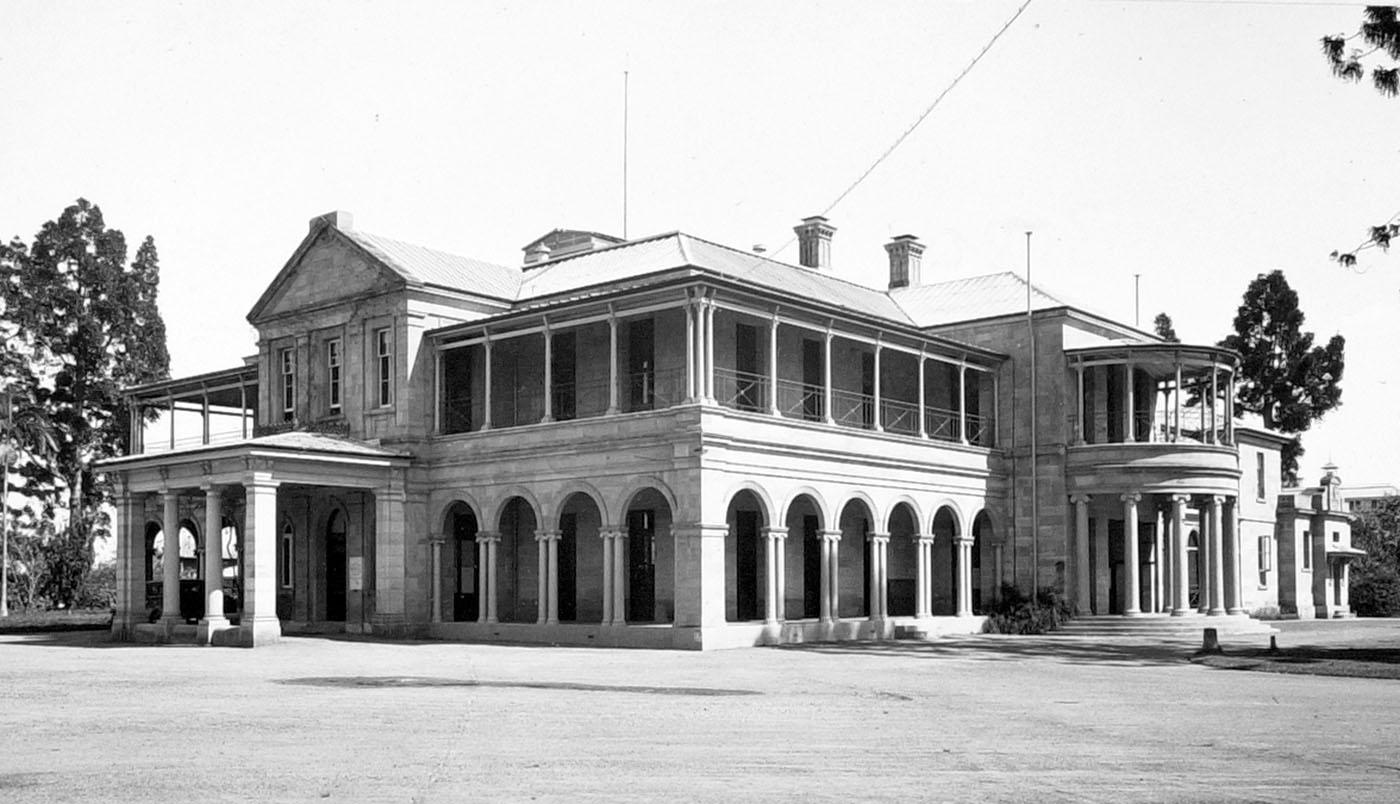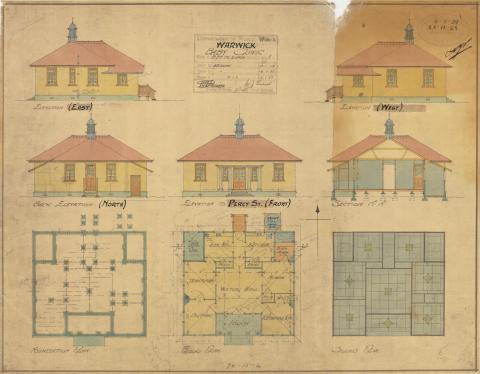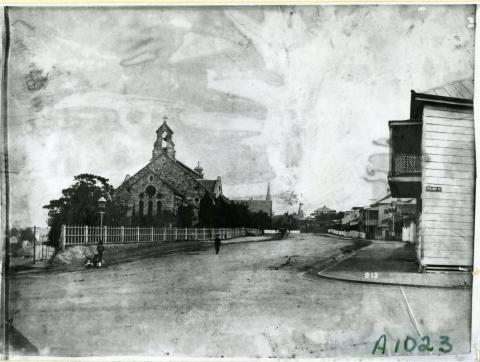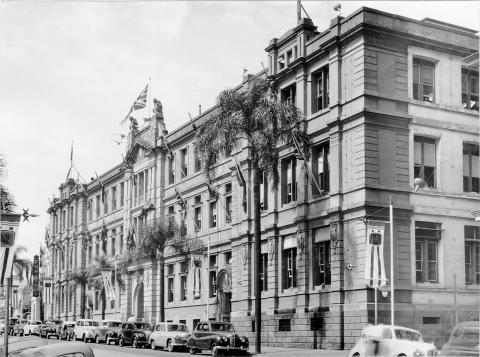
- News of the day
-
Daily Mail, Saturday 24 December 1921, page 14
BRISBANE and Its Institutions
In Story and Picture
OLD GOVERNMENT HOUSE.
SCENE OF PAST SPLENDOURS IV.
For half a century the societal and administrative centre of the State, and for the last 12 years the alma mater of learning in Queensland, as the home of the youngest university in the Southern hemisphere, there is no more romantic building in Brisbane than old Government House.
It stands on a slight eminence - surrounded by lawns and parterres, sloping away to the river which flanks it on three sides - its imposing, solid stone structure part hidden by trees which give it an air of seclusion befitting its dignity. lt followed immediately on the erection of Queensland into an independent Sovereign State, with a responsible Government of its own, and ever since that time, until our State's jubilee was proudly proclaimed, it has been the keystone of our social arch, and the residence of the representative of the Sovereign.
SCENE OF PAST MEMORIES.
The spacious and handsome old building, which looks almost as new as the day it was completed, is the scene of many memories of past splendour, and is intimately associated in the minds of large numbers of residents of Brisbane with the history of Queensland's past, for it was those who made that history who assembled at the functions held within its well-kept grounds and inside its stately walls.
Conditions have changed from time to time in old Government House. The gaiety and splendour of the entertainments held there has waxed and waned, partly in keeping with the disposition of the particular governor who happened to be occupying the place, and partly in keeping with the general prosperity of the State. In this latter respect it has been a mirror of the times, reflecting the periods of prosperity and the lean years through which Queensland has passed.
When, in response to the request of the representatives of some 24,000 residents, Queensland was granted separation from New South Wales, and a charter was issued by Queen Victoria conferring sovereign rights upon the newly-formed State, Sir George Ferguson Bowen, G.C.M.G., was appointed the first Governor. In notifying Sir George of his appointment, Sir Edward Bulwer Lytton tendered him some friendly advice. He said that Sir George would experience the greatest amount of difficulty in connection with the squatters, and warned him to abstain from interference between the rival parties. That was the time when the interests of the pastoralist industry and those of the city dwellers were in a keenly developed stage of political conflict. The advice of Sir Edward Bulwer Lytton was epitomised in the following words. He said: "The first care of the Governor of a free colony is to shun the reproach of being a party man." How well the advice was followed by Sir George Bowen and his successors and with what excellent results is well known to every Queenslander
FIRST GOVERNOR ARRIVES.
Sir George Bowen arrived in Brisbane on December 10, 1859, amidst great popular rejoicings. He read the Queens proclamation, and was sworn in as the first Governor of Queensland by Mr. Justice Lutwyche, the resident Supreme Court Judge for Moreton Bay. In those days there was no Government House, and Sir George was temporarily accommodated in the building now used as St. John's Deanery, and which was leased from the late Dr. Hobbs. One of the first things the Parliament of the time did was to make provision for the Governor's residence. In 1860 a vote of £1,406 was passed for this purpose. In 1861 a further vote of £11,569 was sanctioned, and it was in that year that old Government House was built. In the following year another vote of £5927 was passed. This is clear evidence of the desire of the then Government to see that the direct representative of the King should be suitably housed.
PAST GRAMMARS.
In January, 1868, Sir George Bowen's term of office came to a close, and in August of that year Colonel Samuel Wensley Blackall succeeded him and continued to hold the appointment until January, 1871. From August, 1871, until November, 1874, the Marquis of Normanby supervised the destinies of the State. His successor was Mr. William Wellington Cairns, C.M.G , whose term extended over two years and two months— from January, 1875, to March, 1877. The fifth Governor was Sir Arthur Edward Kennedy, G.C.M.G., C.B., who entered office in April, 1877, and relinquished it in May, 1883. Then came Sir Anthony Musgrave, G.C.M.G., from November, 1883, to October, I888; Sir Henry Wylie Norman, G.C.B., G.C.M.G., C.I.E., from May, 1889, to December, 1895; Lord Lamington, G.C.M.G., from April, 1896, to December, 1901; Sir Herbert Charles Chermside, G.C.M.G., C.B., from March, 1902, to October, 1904; Lord Chelmsford, K.C.M.G. (afterward Governor of New South Wales, and Viceroy of India) from November, 1905, to May, 1909, and Sir William MacGregor, G.C.M.G., C.B., from December, 1909.
DEDICATED TO EDUCATION.
Sir William MacGregor had hardly been installed when the residence was dedicated to the new University of Queensland. The ceremony of dedication took place on December 19, 1909. It was a particularly happy occasion, as it marked the conclusion of 50 years of responsible government in Queensland. At the main entrance to the building stands a marble tablet bearing an inscription that the place was dedicated to the University of Queensland by his Excellency Sir William McGregor, on behalf of the people of Queensland. At the foot of the inscription is the name "W. Kidston,'' the late Dr. Kidston being Premier and Chief Secretary at the time.
From that day until the present old Government House has been the headquarters of the University. On the spacious lawns between it and Parliament House large and modern brick buildings have sprung up to provide accommodation for the ever increasing needs of the University and of the Central Technical College, which later removed there.
RIGID SOCIAL RULES.
It has been mentioned that conditions of social gaiety at old Government House varied with the successive Governors who inhabited it, and with the prevailing times. Perhaps the halcyon days in this respect were during the period of Lord Lamington's term of office. Up to and during this time a strong social code of rules, based largely upon English ideas, was in force. Society was spelt with a capital "S." The result may have been, and probably was, some cause for jealousy amongst various prominent citizens. However, old Government House has never known the rather dubious custom, which was at one time inaugurated by a Governor of New South Wales, of the issue of differently coloured invitation cards to Government House functions. As time went on the English social ideas gave way to those more in keeping with the democratic sentiments of the country.
SALARIES OF THE GOVERNORS.
In looking back upon the entertainments which have been given in Old Government House, it must be remembered that the salaries of the Governor were not always the same. At the commencement, pending a decision by the Parliament of Queensland, the Imperial Government provisionally fixed the Governor's salary at £2500 a year. In the session of 1861 the Queensland Parliament voted an increase to £4000, and made the payment retroactive to January 1, 1860. In 1874 Mr. Oscar de Stage, a member of the Opposition, moved that the salary be increased to £5000 a year. This was adopted by the then Government, and at that figure the salary remained until 1B04, when it was reduced to £3000 a year. This has been the amount of remuneration of the Governors ever since. The reduction was made on account of the hard times through which the State had passed, and also owing to a willingness on the part of Sir Herbert Chermside to set an example in economy.
BOOKS AND LECTURE ROOMS.
The transition from a residence to the headquarters of a university naturally necessitated considerable changes in the interior arrangement of the building. The bedroom where the present King slept when he was in Queensland as Duke of York in 1901 is now a lecture room. In fact all the bedrooms have been fitted with the desks, chairs, blackboards, and other paraphernalia incidental to the instruction of students. On the ground floor the dining room has been turned into a lecture room for the faculty of modern languages, and is also used for examination purposes. The large and small drawing rooms are filled with books and papers of the institution, which are insistently demanding more space.
The A.D.C.'s office is now used by the Registrar of the University, and the billiard room, added to the building in 1899, has been converted into the sanctum for the University Senate. During the week it has been occupied by several young ladies who are busily getting out examination results. All other parts of the building have been similarly transformed.
It appears that in the course of a few years the University, which is speedily outgrowing its present premises, will be moved to where it can more easily expand, probably to Victoria Park. What then will be the fate of the fine, historic old building it is too early to predict, but doubtless some useful purpose will be found for it so that it may continue to play no ignoble part in the progress of the State.
- Background
-
Old Government House was constructed from 1860 to 1862 to the design of Colonial Architect, Charles Tiffin at a cost of £17,000. It served as the home of the various Governors of Queensland from its completion in 1862 until 1910 when it became the inaugural of the University of Queensland.
Queensland became a separate colony in 1859, when Governor Bowen was appointed to govern until electoral roles were established. Robert Herbert was then elected as the first Colonial Secretary, a position akin to the present day Premier. In 1860 funding was allocated by the newly formed Parliament of Queensland for the construction of Government House. This was to be the first major public building which the Parliament planned.
A site was chosen for the house adjacent to the Botanic Gardens which had been established on the site of a government garden in 1855, when the curator, Walter Hill, was employed. Originally, the intention of the government was to construct a larger Government House in the country and therefore Government House was smaller than other Government Houses of Australia. It was described by the architect, Charles Tiffin, as the most economical vice regal residence in the Australian Colonies. £17,000 was allocated for the construction of the building, which was a major undertaking for a small colony of only 30, 000 settlers, facing an uncertain economical future.
Charles Tiffin was born in Newcastle, England and emigrated to the colonies in the mid 1850s, when he arrived in Victoria. He was appointed to the position of Clerk of Works for Moreton Bay in May 1857. Tiffin was responsible for the designs of a range of public buildings, the first of his major projects being the Ipswich Court House, extant in 1995. After separation, Tiffin became Queensland's first Colonial Architect.
Government House provided family accommodation, public reception areas and government offices. The house was carefully designed to take advantage of its siting on a promontory. The formal entrance and function rooms faced the river, away from the growing township; the offices were located to the north-east of the building; family quarters were on the south west and the rear north west of the building, housed servant's quarters and kitchen areas. By June 18, 1862, the Queensland Daily Guardian, reported that Governor and Lady Bowen had been in residence at Government House for one month, and that the building appears to be well adapted in point of coolness and ventilation to the climate of this colony; the rooms being large, lofty and airy, and furnished in a plain but exceedingly tasteful manner.
The house demonstrates an early understanding of ventilation principles in sub-tropical climates, in which Tiffin was known to be interested. Features of the house like the ventilated lantern, the large number of french doors, and the sliding doors on the ground floor, suggest a concern for air movement in the building.
The grounds surrounding the building were laid out by the director of the botanical Gardens, Mr Walter Hill, and it is understood that Lady Bowen also took a great interest in the gardens The grounds were thought to reflect the highest credit on Mr Walter Hill. A detailed description of the areas on each side of the house (comprised) a raised terrace, half moon and crescent shaped, neatly covered with sods of grass, and traced out in various designs for the cultivation of flowers and plants.
Governor Bowen remained at Government House until 1868, when he was recalled to England and Colonel Samuel Blackall became the new Governor of Queensland. Many alterations were made during the 1870s which saw the house adopt a more tropical form, most obviously with the addition of first floor verandahs, thereby distinguishing it from Government Houses in other states. Functions organised by the various Governors became larger to accommodate the larger population, and a prefabricated supper room/ballroom was erected on the lawn to the south west adjacent to the drawing room. In 1895, the house was completely redecorated. Old Government House was extended with a Billiard Room on the northern corner of the building in 1899.
The Federation of Australia, meant a reduction in the role of the Governor, but the real diminishing of their powers came about in around 1910 with the abolishment of the Upper House.
A committee was formed by the Premier, Mr Kidston, to select a site for a University in Queensland, and their recommendation was the Domain which was the grounds of the, then, Government House. In 1909 the House was dedicated to the new university, with five acres around it set aside for both a university and a technical college, with the remaining area given over to the Botanic Gardens. The Governor, who was then MacGregor, moved out of the house in 1910, to what were thought to be temporary arrangements at Fernberg, Paddington. By 1914, the new grounds of the University and Technical College were deemed unsuitable, and bids were made for the return of the Governor to the house, but these were unsuccessful.
Though the University transferred to St Lucia in 1945 it still retained many rooms in the former Government House. As the State Government retained the ownership of the former Government House, it was put to use by various official departments, and suffered from deterioration. In 1973 the National Trust moved into the building on the basis that they would gradually become the custodians of the entire building. Extensive alterations were carried out by the State Works Department, which again caused damage to the original fabric of the building. By 1982 the National Trust had assumed control over most of the building. The Technical College became the Queensland Institute of Technology, which in turn became the Queensland University of Technology and remains on the site surrounding Old Government House.
Courtesy of Queensland Heritage Register
/153.0294308,-27.4774713,7/450x450@2x.png?access_token=pk.eyJ1IjoicXNhLWRpc2NvLXFsZCIsImEiOiJjamJmdTgyZXEyeWNjMnlxZm8xcmtieHgxIn0.lmT9J5tTPKGuuccQgCVSAg)



